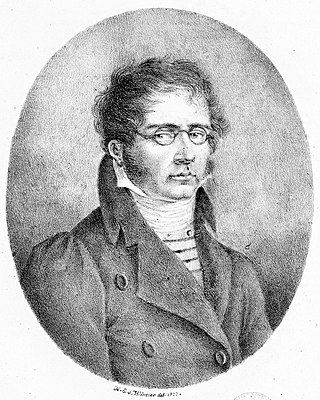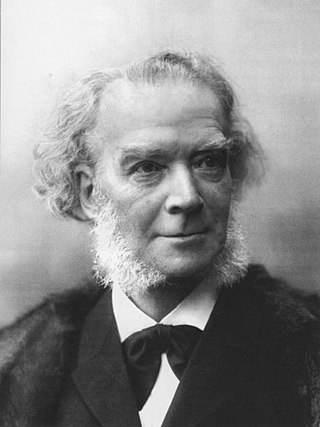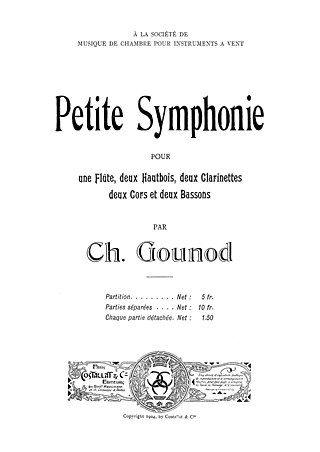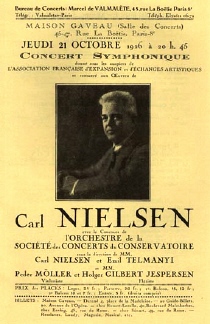
Carl August Nielsen was a Danish composer, conductor and violinist, widely recognized as his country's most prominent composer.

Franz Ignaz Danzi was a German cellist, composer and conductor, the son of the Italian cellist Innocenz Danzi (1730–1798) and brother of the noted singer Franzeska Danzi. Danzi lived at a significant time in the history of European music. His career, spanning the transition from the late Classical to the early Romantic styles, coincided with the origin of much of the music that lives in our concert halls and is familiar to contemporary classical-music audiences. In his youth he knew Wolfgang Amadeus Mozart, whom he revered; he was a contemporary of Ludwig van Beethoven, about whom he — like many of his generation — had strong but mixed feelings and he was a mentor for the young Carl Maria von Weber, whose music he respected and promoted.
Robert Wilfred Levick Simpson was an English composer, as well as a long-serving BBC producer and broadcaster.
Carl Nielsen's Concerto for Clarinet and orchestra, op. 57 [D.F.129] was written for Danish clarinetist Aage Oxenvad in 1928. The concerto is presented in one long movement, with four distinct theme groups.

Carl Heinrich Carsten Reinecke was a German composer, conductor, and pianist in the mid-Romantic era.

Vagn Gylding Holmboe was a Danish composer and teacher.
Symphony No. 6 "Sinfonia semplice", FS 116, was Danish composer Carl Nielsen's last symphony.
Václav Nelhýbel was a Czech American composer, mainly of works for student performers.

The Violin Concerto No. 3 in B minor, Op. 61, by Camille Saint-Saëns is a piece for violin and orchestra written in March 1880. Saint-Saëns dedicated the concerto to fellow composer-virtuoso Pablo de Sarasate, who performed the solo part at the premiere in October 1880 in Hamburg.
Walter Sinclair Hartley was an American composer of contemporary classical music.
In music, a nonet is a chamber music composition which requires nine musicians for a performance. The standard nonet scoring is for wind quintet, violin, viola, cello, and double bass, though other combinations are also found. Additionally, the term may apply to a group of nine musicians regardless of whether they are playing chamber music.

The Danish composer Carl Nielsen wrote his Symphony No. 3 "Sinfonia Espansiva", Op. 27, FS 60, between 1910 and 1911. Around 35 minutes in length, it is unique in his symphonic output for having vocal parts, specifically wordless solos for soprano and baritone in the second movement.

Jaroslav Řídký was a Czech composer, conductor, harpist, and music teacher.
The Flute Concerto by Robert Simpson was composed in 1989 and dedicated to Susan Milan, the flautist who commissioned the work and gave its premiere in May 1992 at the Malvern Festival with the City of London Sinfonia conducted by Richard Hickox.

The trumpet repertoire consists of solo literature and orchestral or, more commonly, band parts written for the trumpet. Tracings its origins to 1500 BC, the trumpet is a musical instrument with the highest register in the brass family.

Carl Nielsen's Wind Quintet, or as indicated by the original score, the Kvintet for Flöte, Obo, Klarinet, Horn og Fagot, Op. 43, was composed early in 1922 in Gothenburg, Sweden, where it was first performed privately at the home of Herman and Lisa Mannheimer on 30 April 1922. The first public performance was on 9 October 1922 in the smaller hall at the Odd Fellows Mansion in Copenhagen. It is considered a staple of the repertoire for wind quintet.
Aage Oxenvad was a Danish clarinetist who played in the Royal Danish Orchestra from 1909. Carl Nielsen wrote his Clarinet Concerto for Oxenvad who played at its premiere in 1928.

Holger Gilbert-Jespersen was a Danish flutist, orchestral musician and academic flute teacher. In 1926, Carl Nielsen's Flute Concerto was written for, dedicated to, and first performed by Gilbert-Jespersen in Paris. He was a member of the Royal Danish Orchestra from 1927 to 1956 as well as a professor at the Royal Danish Academy of Music from 1927 to 1962, where he trained generations of flutists.

The Petite Symphonie in B-flat major is a four-movement work by Charles Gounod, first performed in 1885. It is scored for a wind ensemble of nine players.













